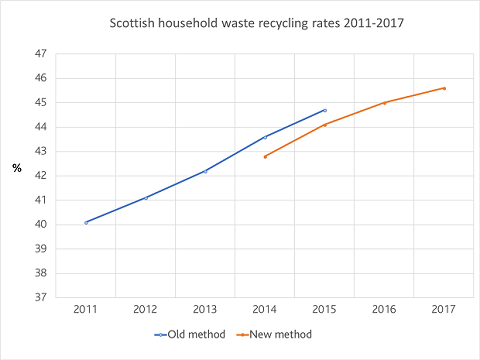Data published by SEPA shows that the amount of household waste recycled, reused, or composted across Scotland’s local authorities increased above landfill for the first time last year.
The recycling rate for Scottish household waste increased to 45.6% for the calendar year 2017, to 1.12 million tonnes. This equates to an increase of 0.6 percentage points on the previous year.
Meanwhile, the amount of Scottish household waste landfilled in 2017 fell to 1.11 million tonnes – a decrease of 24,848 tonnes from 2016.
The total amount of household waste generated between January and December also decreased by 38,152 tonnes to 2.46 million tonnes.
And, around 175,296 tonnes of Scotland’s household waste was managed by incineration, according to SEPA – a drop from 188,623 tonnes in 2016.
Local authorities
Out of the 32 Scottish local authorities which submitted data, Moray had the highest recycling rate for 2017, at 59.1%. Meanwhile, the Shetland Islands recorded the lowest rate at just 7.9%.
The largest type of household waste recycled or reused in 2017 was paper and cardboard wastes (225,495 tonnes).
Despite the decrease in household waste landfilled, the total amount of waste landfilled in Scotland in 2017 was 3.83 million tonnes, an increase of 90,816 tonnes from 2016.
The increase was primarily due to an increase in the landfill of soils – such as waste soils and rocks from construction sites, SEPA explained, which increased by 230,748 tonnes from 2016.
The total quantity of waste incinerated in Scotland also increased in 2017. This equated to 766,574 tonnes – an increase of 83,347 tonnes from 2016.
The SEPA data also showed that over one quarter (300,735 tonnes) of the total household waste landfilled first passed through another waste management facility. “These included any reject wastes from mixed waste that was sent to waste sorting facilities for segregation prior to recycling, and it also included combustion waste outputs from incineration facilities,” SEPA revealed.
For the first time the official statistics also show the carbon impact of Scottish household waste generated and managed in 2017. “This is a measure of the whole-life carbon impacts of waste, from resource extraction and manufacturing emissions, right through to waste management emissions,” SEPA says.
Carbon
The carbon impact of household waste generated and managed in 2017 was 5.86 million tonnes of carbon dioxide equivalent; this was a decrease of 115,938 tonnes of carbon dioxide equivalent (1.9%) from 2016, and a decrease of 904,491 tonnes of carbon dioxide equivalent (13.4%) from 2011.
According to SEPA, data on waste is collected to monitor policy effectiveness, and to support policy development, particularly commitments in the Scottish Government’s Making Things Last – A Circular Economy Strategy for Scotland.
The post Household recycling exceeds landfill in Scotland appeared first on letsrecycle.com.
Source: letsrecycle.com Waste Managment




